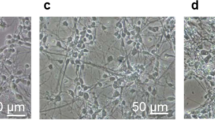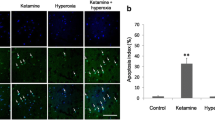Abstract
During development, anesthetics activate neuroapoptosis and produce damage in the central nervous system that leads to several types of neurological disorders. A single dose of ketamine (40 mg/kg) during synaptogenesis in a 7-day-old rat brain activated the apoptotic cascade and caused extensive neuronal cell death in the forebrain. In this study, we investigated the protective effect of nicotinamide against ketamine-induced apoptotic neurodegeneration. After 4 h, neuronal cell death induced by ketamine was associated with the induction of Bax, release of cytochrome c into the cytosol, and activation of caspase-3. One single dose of 1 mg/g nicotinamide was administered to a developing rat and was found to inhibit ketamine-induced neuroapoptosis by downregulating Bax, inhibiting cytochrome c release from mitochondria into cytosol, and inhibiting the expression of activated caspase-3. TUNEL and immunohistochemical analyses showed that ketamine-induced cell death occurred through apoptosis and that it was inhibited by nicotinamide. Fluoro-Jade-B staining demonstrated an increased number of dead cells in the cortex and thalamus after ketamine treatment; treatment with nicotinamide reduced the number of dead cells in these brain regions. Our findings suggest that nicotinamide attenuated ketamine-induced neuronal cell loss in the developing rat brain and is a promising therapeutic and neuroprotective agent for the treatment of neurodevelopmental disorders.






Similar content being viewed by others
References
Anand KJ, Soriano SG (2004) Anesthetic agents and the immature brain: are these toxic or therapeutic? Anesthesiology 101:527–530
Anderson KJ, Miller KM, Fugaccia I, Scheff SW (2005) Regional distribution of Fluoro-Jade B staining in the hippocampus following traumatic brain injury. Exp Neurol 193:125–130
Ayoub IA, Lee EJ, Ogilvy C, Flint BM, Maynard KI (1999) Nicotinamide reduces infarction up to two hours after the onset of permanent focal cerebral ischemia in wistar rats. Neurosci Lett 259:21–24
Bernardi P, Krauskopf A, Basso E, Petronilli V, Blachly-Dyson E, Di LF et al (2006) The mitochondrial permeability transition from in vitro artifact to disease target. FEBS J 273:2077–2099
Bhargava R, Young KD (2007) Procedural pain management patterns in academic pediatric emergency departments. Acad Emerg Med 14:479–482
Burkle A (2001) PARP-1: a regulator of genomic stability linked with mammalian longevity. Chembiochemistry 2:725–728
Chong ZZ, Lin SH, Maiese K (2002) Nicotinamide modulates mitochondrial membrane potential and cysteine protease activity during cerebral vascular endothelial cell injury. J Vasc Res 39:131–147
Chong ZZ, Lin SH, Maiese K (2004) The NAD + precursor nicotinamide governs neuronal survival during oxidative stress through protein kinase B coupled to FOXO3a and mitochondrial membrane potential. J Cereb Blood Flow Metab 24:728–743
Chong ZZ, Lin SH, Li F, Maiese K (2005) The sirtuin inhibitor nicotinamide enhances neuronal cell survival during acute anoxic injury through Akt, Bad, PARP, and mitochondrial associate “anti-apoptotic” pathways. Curr Neurovasc Res 2:271–285
Hengartner MO (2000) The biochemistry of apoptosis. Nature 407:770–776
Ikonomidou C, Bosch F, Miksa M, Bittigau P, Vockler J, Dikranian K et al (1999) Blockade of NMDA receptors and apoptotic neurodegeneration in the developing brain. Science 283:70–74
Jevtovic-Todorovic V, Hartman RE, Izumi Y, Benshoff ND, Dikranian K, Zorumski CF et al (2003) Early exposure to common anesthetic agents causes widespread neurodegeneration in the developing rat brain and persistent learning deficits. J Neurosci 23:876–882
Johnson KM, Phillips M, Wang C, Kevetter GA (1998) Chronic phencyclidine induces behavioral sensitization and apoptotic cell death in the olfactory and piriform cortex. J Neurosci Res 52:709–722
Klaidman LK, Mukherjee SK, Hutchin TP, Adams JD (1996) Nicotinamide as a precursor for NAD + prevents apoptosis in the mouse brain induced by tertiary-butylhydroperoxide. Neurosci Lett 206:5–8
Klaidman LK, Mukherjee SK, Adams JD (2001) Oxidative changes in brain pyridine nucleotides and neuroprotection using nicotinamide. Biochim Biophys Acta 1525:136–148
Klaidman L, Morales M, Kem S, Yang J, Chang ML, Adams JD (2003) Nicotinamide offers multiple protective mechanisms in stroke as a precursor for NAD+, as a PARP inhibitor and by partial restoration of mitochondrial function. Pharmacology 69:150–157
Krauss B, Green SM (2006) Procedural sedation and analgesia in children. Lancet 367:766–780
Laraci A, Herrera DG (2006) Nicotinamide protects against ethanol-induced apoptotic neurodegeneration in the developing mouse brain. PLoS Med 3:547–557
Li P, Nijhawan D, Budihardjo I, Srinivasula SM, Ahmad M, Alnemri ES et al (1997) Cytochrome c and dATP-dependent formation of Apaf-1/caspase-9 complex initiates an apoptotic protease cascade. Cell 91:479–489
Maiese K, Chong ZZ (2003) Nicotinamide: necessary nutrient emerges as a novel cytoprotectant for the brain. Trends Pharmacol Science 24:228–232
Mukherjee SK, Klaidman LK, Yasharel R, Adams JD (1997) Increased brain NAD prevents neuronal apoptosis in vivo. Eur J Pharmacol 330:27–34
Mukherjee S, Sonee M, Adams JD (2005) A review of the regulatory role of nicotinamide on pro- and anti-apoptotic proteins in neuronal cells. Lett Drug Des Discov 2:551–557
Olney JW, Tenkova T, Dikranian K, Muglia LJ, Jermakowicz WJ, D’Sa C et al (2002) Ethanol-induced caspase-3 activation in the in vivo developing mouse brain. Neurobiol Dis 9:205–219
O’Rourke B, Cortassa S, Aon MA (2005) Mitochondrial ion channels: gatekeepers of life and death. Physiology 20:303–315
Rupinder SK, Gurpreet AK, Manjeet S (2007) Cell suicide and caspases. Vascul Pharmacol 46:383–393
Sas K, Robotka H, Rozsa E, Agoston M, Szenasi G, Gigler G et al (2008) Kynurenine diminishes the ischemia-induced histological and electrophysiological deficits in the rat hippocampus. Neurobiol Dis 32:302–308
Scallet AC, Schmued LC, Slikker W, Grunberg N, Faustino PJ, Davis H et al (2004) Developmental neurotoxicity of ketamine: morphometric confirmation, exposure parameters, and multiple fluorescent labeling of apoptotic neurons. Toxicol Sci 81:364–370
Slikker W, Xu Z, Wang C (2005) Application of a systems biology approach to developmental neurotoxicology. Reprod Toxicol 19:305–319
Slikker W, Zou X, Hotchkiss CE, Divine RL, Sadovova N, Twaddle NC et al (2007) Ketamine-induced neurodegeneration in the perinatal rhesus monkey. Toxicol Sci 98:145–158
Ungerstedt JS, Blomback M, Soderdtom T (2003) Nicotinamide is a potent inhibitor of proinflammatory cytokines. Clin Exp Immunol 131:48–52
Wang C, Kaufmann JA, Sanchez-Ross MG, Johnson KM (2000) Mechanisms of N methyl-d-aspartate-induced apoptosis in phencyclidine treated cultured forebrain neurons. J Pharmacol Exp Ther 294:287–295
Wang C, Sadovova N, Fu X, Schmued L, Scallet A, Hanig J et al (2005) The role of the N-methyl-d-aspartate receptor in ketamine-induced apoptosis in rat forebrain culture. Neuroscience 132:967–977
Wang C, Sadovova N, Hotchkiss C, Fu X, Scallet AC, Patterson TA et al (2006) Blockade of N-methyl-d-aspartate receptors by ketamine produces loss of postnatal day 3 monkey frontal cortical neurons in culture. Toxicol Sci 91:192–201
Wozniak DF, Hartman RE, Boyle MP, Vogt SK, Brooks AR, Tenkova T et al (2004) Apoptotic neurodegeneration induced by ethanol in neonatal mice is associated with profound learning/memory deficits in juveniles followed by progressive functional recovery in adults. Neurobiol Dis 17:403–414
Yang J, Klaidman LK, Chang ML, Kem S, Sugawara T, Chan P et al (2002a) Nicotinamide therapy protects against both necrosis and apoptosis in a stroke model. Pharmacol Biochem Behav 73:901–910
Yang J, Klaidman LK, Nalbandian A, Oliver J, Chang ML, Chan PH et al (2002b) The effects of nicotinamide on energy metabolism following transient focal cerebral ischemia in Wistar rats. Neurosci Lett 333:91–94
Young C, Roth KA, Klocke BJ, West T, Holtzman DM, Labruyere J et al (2005) Role of caspase-3 in ethanol-induced developmental neurodegeneration. Neurobiol Dis 20:608–614
Zamzami N, Kroemer G (2001) The mitochondrion in apoptosis: how Pandora’s box opens. Nat Rev Mol Cell Biol 2:67–71
Acknowledgments
This work was supported by Rural Development Administration (Agenda: PJ007361) and Next-Generation Biogreen 21 program (PJ008075) funded by the Korean government.
Author information
Authors and Affiliations
Corresponding author
Additional information
Najeeb Ullah, Ikram Ullah and Hae Young Lee contributed equally to this work.
Rights and permissions
About this article
Cite this article
Ullah, N., Ullah, I., Lee, H.Y. et al. Protective Function of Nicotinamide Against Ketamine-induced Apoptotic Neurodegeneration in the Infant Rat Brain. J Mol Neurosci 47, 67–75 (2012). https://doi.org/10.1007/s12031-011-9685-1
Received:
Accepted:
Published:
Issue Date:
DOI: https://doi.org/10.1007/s12031-011-9685-1




